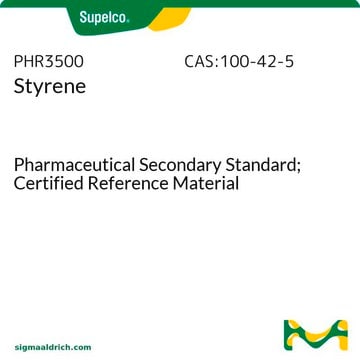W323306
Styrene
≥99%
Synonym(s):
Phenylethylene, Vinylbenzene
About This Item
Recommended Products
biological source
synthetic
reg. compliance
FDA 21 CFR 172.515
vapor density
3.6 (vs air)
vapor pressure
12.4 mmHg ( 37.7 °C)
4.3 mmHg ( 15 °C)
Assay
≥99%
form
liquid
autoignition temp.
490 °F
914 °F
may contain
<15 ppm 4-tert-butylcatachol, synthetic as stabilizer
expl. lim.
6.1 %
availability
not available in USA
Looking for similar products? Visit Product Comparison Guide
related product
Signal Word
Danger
Hazard Statements
Precautionary Statements
Hazard Classifications
Acute Tox. 4 Inhalation - Aquatic Chronic 3 - Asp. Tox. 1 - Eye Irrit. 2 - Flam. Liq. 3 - Repr. 2 - Skin Irrit. 2 - STOT RE 1 Inhalation - STOT SE 3
Target Organs
hearing organs, Respiratory system
Storage Class Code
3 - Flammable liquids
WGK
WGK 2
Flash Point(F)
89.6 °F - closed cup
Flash Point(C)
32.0 °C - closed cup
Personal Protective Equipment
Choose from one of the most recent versions:
Already Own This Product?
Find documentation for the products that you have recently purchased in the Document Library.
Customers Also Viewed
Our team of scientists has experience in all areas of research including Life Science, Material Science, Chemical Synthesis, Chromatography, Analytical and many others.
Contact Technical Service












